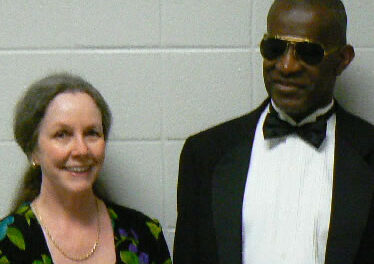Baroque and Beyond is a series of period music concerts held in historic buildings and notable homes in Chapel Hill. It draws upon a pool of local and guest musicians dedicated to historically informed performance practices. The series is presented by the Preservation Society of Chapel Hill. Music director Beverly Biggs is a widely experienced performer on period keyboard instruments.
Regular fans of Baroque and Beyond welcomed the great sightlines and acoustics of the Chapel of the Cross, consecrated in 1848. In the ensemble’s usual venues (such as the Horace Williams House), music lovers are scattered through several adjoining rooms. Beverly Biggs accompanied most of the works on this enterprising program using her exact replica of a 1784 Andreas Stein, Vienna, fortepiano. The artists in this concert used a baroque cello and violin, played with classical period bows. While the clarinet was a modern one, a special head joint and reed were used, historically informed practices were observed, and concert pitch was a tick lower at A=438.
The works of Carl Philippe Emanuel Bach (1714-88) are transitional, building upon Baroque forms and evolving into Classical style. His keyboard sonatas and symphonies have a reputation of being “wild” because of his application of a philosophical strain of the time, empfindsamer Stil or sensitive style, which gives free rein to emotions. C.P.E. Bach’s violin and keyboard sonatas are even wilder. The Sonata in B-flat, Wq. 77, in three movements, is a fine example. The composer plays with the conventional relationship between the two instruments while moods and tempos make abrupt changes. Biggs’ fortepiano was balanced with John Pruett’s violin and blended with it well. The hairpin changes were executed superbly, and the racing passages were clear despite the tempos. Both players made the most of solo opportunities the composer gave them.
Music lovers rarely think of Franz Schubert (1797-1828) as an opera composer and even more rarely get a chance to sample an aria from one of his efforts. Received opinion is his lyrical talents were wasted on truly inferior librettos. Nevertheless, Baroque and Beyond programmed the “Romanze” from Schubert’s one act Die Verschworenen (The Conspiraror), D.787, composed in 1823. Apparently the title alone was sufficient for the censor to prevent its production. Regarded as the composer’s best attempt to compose an opera, the light-hearted singspiel about the impossibility of abstinence is very loosely based upon Aristophanes’ play Lysistrata. In the “Romanze” for soprano, clarinet, strings, and continuo, Helene laments the prolonged absence of her husband Astaff. Florence Peacock powerfully projected the text with her usual excellent diction and refined care for word meaning. The spare accompaniment was played expressively by clarinetist Gilmore and violinist Pruett while bass support was provided by cellist Stephanie Vial and Biggs’ mellow fortepiano.
Franz Joseph Haydn (1732-1809) was the “father” of the symphony, the string quartet, and the piano trio, developing existing forms to their mature Classical forms. His works appear too infrequently at every concert level so any chance to hear one of his piano trios is all the more welcome. His Trio in C, H.XV:21, was published in London in 1795. It is in three movements; “Adagio pastorale/Vivace assai,” “Andante molto,” and “Finale/Presto.” The typical slow introduction leads into the melodically rich first movement, and a droning figure suggests a bagpipe. The gentle, pastoral slow movement features a fine solo episode for the keyboard.
The lively finale is hearty with playful hesitations. Biggs, Pruett, and Vial turned in a lively, stylish performance.
The Trio in C, Op. 87 of Ludwig van Beethoven (1770-1827) was originally composed for two oboes and English horn and was part of the growing market of music for amateur players and was intended to be played by three Teimer brothers. Beethoven made the first arrangement for two violins and violas and there have been several arrangements of this work for other combinations. This concert premiered the Trio in C for Violin, Clarinet, and Cello, a joint effort of Jimmy Gilmore and Stephanie Vial. In humorous, self-effacing comments before the performance, Gilmore said he made sure the fast first oboe passages ended up scored for the violin. Vial elaborated the cello part from the original version. Pruett, Gilmore, and Vial brought out all the charm and good humor of this early Beethoven piece, not least in what Gilmore had called “barnyard” noises in the spirited finale.
Schubert’s song “Der Hirt auf dem Felsen”(“The Shepherd on the Rock”), D.965, is one of his best known; it has often been performed in our area. It was composed for the operatic soprano Pauline Anna Milder-Hauptmann, a friend of the composer, who wanted a showpiece to display a wide range of feelings. It was published a year and a half after Schubert died, and Midler premiered it at the House of the Blackheads in Riga on February 10, 1830. Some reference works call the piece a cantata while others call it chamber music. Baroque and Beyond’s bare-bones program did not include texts but I had the original German and an English translation at hand.
Florence Peacock’s diction was excellent, and she carefully gauged the palette of emotions across the seven verses. Gilmore’s breath control was consummate, as was his range of color. The clarinet part’s melodies “echoed” the lines of the singer, evoking the shepherd’s calls in the high mountains. His extended solo before the last lamenting verse and the dramatic mood swing at Spring’s advent were marvelous. Biggs fortepiano accompaniment was a model of its type.












